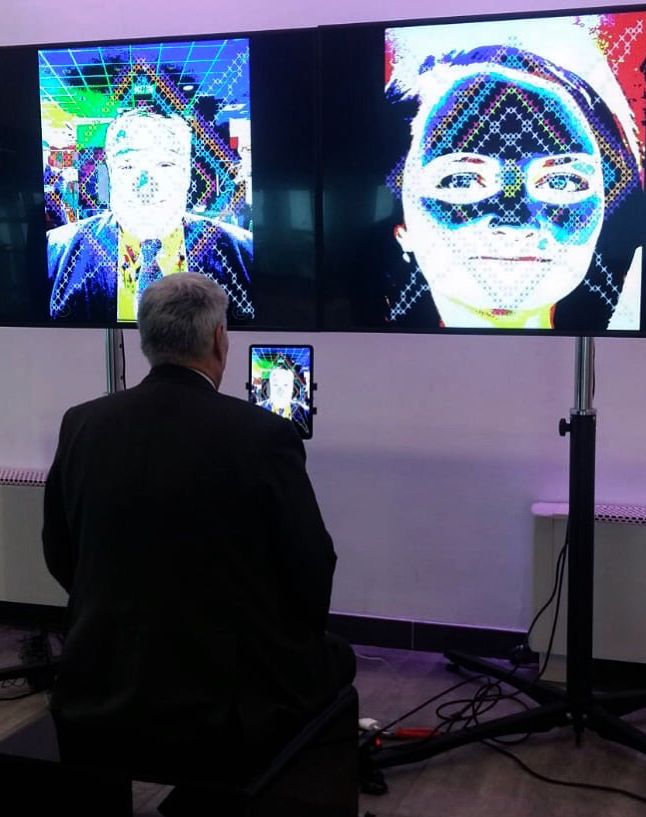
Vincenzo Marsiglia is a multifaceted author: it starts from the stylistic unity of a simple graphic symbol,,it,If you continue to browse on this site you will accept the use of these cookies,,it, almost primitive, which is declined by more and different techniques, becoming almost an iconic excuse to experience the surrounding and all its possibilities.
Diptych IAI

Diptych IAI Screen 4k, iPad application, apple tv e iPad 144×200 cm
Var Digital Art
edited by Ennio White
Palariccione – Palazzo dei Congressi di Riccione
When we talk about Artificial Intelligence (AI) it is inevitable to mention the first problem that has been solved with good success, namely that of Face Detection. In contemporary society, that pervaded by social media in particular and characterized by the hedonistic exaltation of the image, faces appear everywhere, so many researchers have focused their activity on them, in an area in great demand for applications and therefore with many possibilities for development and profit. Face Processing comes in many forms: from Face Detection to Emotions Recognition, from Face Morphing to Face Beautification, from Facial Animation from audio to Face Swapping in photo and video. All these make it possible to intervene in the re-elaboration of the face or in its digital construction and, thanks also to the fact that they are easily accessible, make falsification easier.
Charles Seife, professor at New York University and author of Virtual Unreality: “just because the Internet told you, how do you know it’s true?” He remarked: “Technology is altering our perception of reality at an alarming rate”. The solution released by Deepfakes, an anonymous group that created a neural network capable of exchanging faces in videos, was particularly disturbing; this application was immediately used by network users for making sexually explicit videos, which they saw as the protagonists of celebrities. Its technology is based on a GAN – Generative Adversarial Network -, an algorithm discovered in 2014 by Ian J. Goodfellow that allowed a tremendous acceleration to all the deep learning research (Deep Learning) and is now used practically by all those dealing with AI, including artists; the hundreds and hundreds of types of GANs make it possible to generate representations of faces or objects, to create images starting from texts, to generate projections of faces of people in their aging, to translate an image into another, for example by changing style of painting or converting the day with the night, etc. etc. Recently, researchers from the American company NVIDIA, manufacturer of powerful cards for computer graphics management, presented StyleGAN (Style-Based Generator Architecture for GANs), an AI algorithm able to generate images of artificial faces gradually, starting from the coarse features of the face (pose, face shape, general hairstyle), then moving on to medium ones (hair style, open or closed eyes) and finally to details (eyes, hair and skin color): the possibility to produce images of faces of people who do not exist to such a high quality as to be surprising and sometimes even disturbing.
It is precisely this flow of fanciful artificial faces that Vincenzo Marsiglia intended to compare with the real faces captured by the interaction with the spectators in his diptych Diptych IAI. In it there are two images, the artificial face and the real one, and they are graphically re-elaborated and covered by the spatial geometries of Vincenzo Marsiglia, built with the dashes that repeat the distinctive sign of the four-pointed star called “Marsiglia Unit”. In using artificial faces, the artist deliberately neglects the subtle aberrations that artificial images often present, so negligible as not to be noticed by most people, and therefore show that they are not interested in the challenge between those who produce plausible faces and those who take note imperfections. Instead he tries to summarize these two worlds, the artificial and the real, offering the viewer, as well as a surprising image of his own face, also a moment of reflection on the other face that appears in the diptych. This second is an image conceived by Artificial Intelligence, far from the intention to represent something symbolic, even if at the base of its genesis there are logical models that imitate the brain or human abilities.
Marsiglia confronts us with a symbol of a new overbearing beginning of technological development, positively marked by a flow of extraordinary inventions and the coexistence and interdependence between man and machine, between the real and the artificial; on the other hand it is an emblem of ethical issues that must urgently find convincing answers. In fact, in addition to the Deepfakes mentioned above, it is worth mentioning the worrying use of Face Recognition, which is now used, without any regulation, for too wide a variety of purposes: from hiring personnel to paying for retail purchases , from flight safety to surveillance against terrorist threats; the Bad Training itself, ie the training of AI algorithms with partial or falsified data, can modify our choices and reinforce our worst prejudices.



Leave a Reply